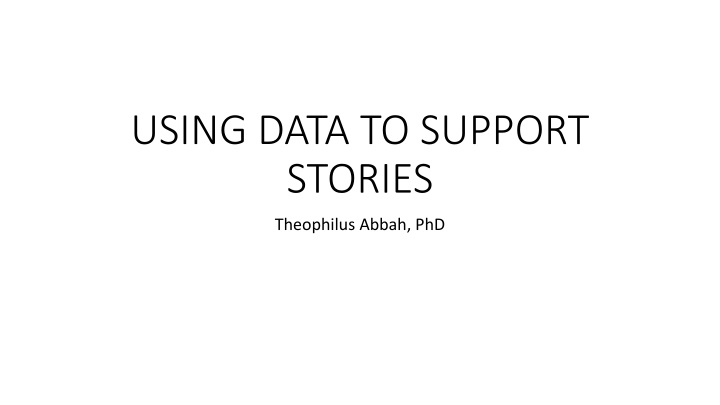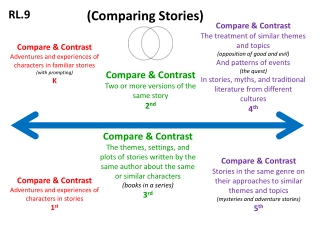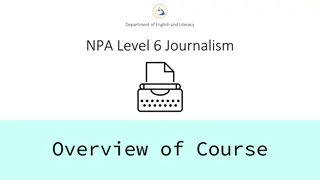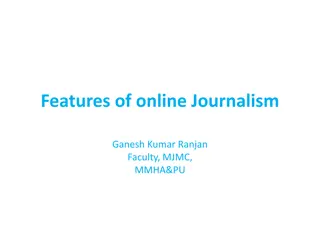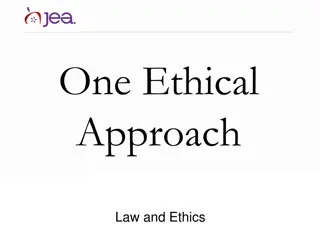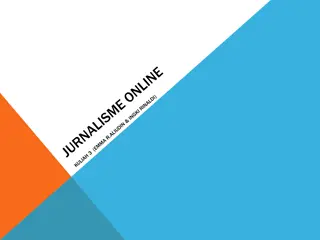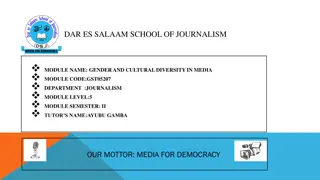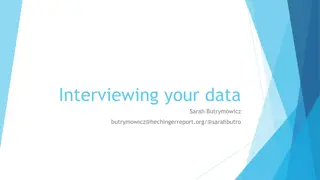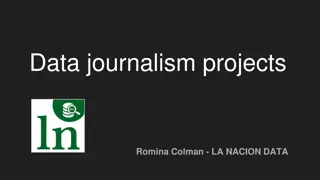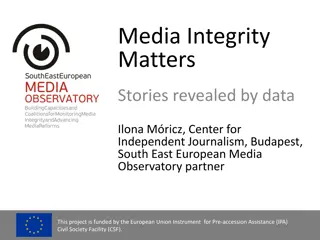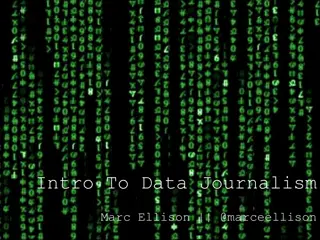Using Data to Support Stories in Journalism
Data plays a crucial role in modern journalism, enabling the presentation of compelling stories through statistics, visualization, and analysis. Social scientists have long used data to understand phenomena and make informed predictions. Today, journalists leverage data to create impactful narratives, utilizing tools such as data mining and visualization to gather insights and present information effectively. This article explores the significance of data journalism in storytelling and highlights its various applications in the digital age.
Download Presentation

Please find below an Image/Link to download the presentation.
The content on the website is provided AS IS for your information and personal use only. It may not be sold, licensed, or shared on other websites without obtaining consent from the author.If you encounter any issues during the download, it is possible that the publisher has removed the file from their server.
You are allowed to download the files provided on this website for personal or commercial use, subject to the condition that they are used lawfully. All files are the property of their respective owners.
The content on the website is provided AS IS for your information and personal use only. It may not be sold, licensed, or shared on other websites without obtaining consent from the author.
E N D
Presentation Transcript
USING DATA TO SUPPORT STORIES Theophilus Abbah, PhD
Introduction Data brings to mind statistics: facts, figures and numbers. We also have symbols, images in the form of visualization Computers: data processing Quantitative data: use of numbers
Introduction Data has been in use by social scientists over the years in order to understand phenomena and to predict what should be done. How do people spend their money? What businesses should we engage in? This is basically precision research, which has been in vogue before the computer.
Computer-Assisted Reporting Data Mining Data Cleaning/Sorting Computer Data Publication Analysis/Visualization
Data in stories In today s journalism data is used to present stories in a compelling manner: Read this story: What is the situation in Gaza s Khan Younis as Israel intensifies attacks? | Israel-Palestine conflict News | Al Jazeera
Story presentation Maps Information presented in percentages Pie charts Bar charts Line charts Visualization using symbols Timelines
Data in stories Read this BBC story: The impact will be felt in Ukraine war if US aid dries up - BBC News
Why data journalism? I. A (not too) new approach to story-telling, similar to the use of photographs, video, audio (podcast), livestreaming, etc. II. Making sense by filtering abundant data or sense-making journalism III. Providing deep insight IV. Showing trends and implications V. Explainers VI. Lasting impression with infographics and visualization
How do journalists gather data? In the age of the Internet, data gathering is made easier because of diverse tools that are available. What journalists must strive to do is know how to use the various tools. This is what data mining is all about. We need primary data & secondary data. For instance, in trying to find out why the military would mistakenly kill so many persons in Igabi Local Government Area in Kaduna State, you may want to know how bandits threaten the lives of the people in the area. You could just do simple Google Search
Google Advanced Search File types: pdf, xls, ppt, csv, etc. Search within a website Date or period Specific words that must be included Specific words that must not be included Exact words or phrases Narrow to region, language, etc
Using Google If you right-click your mouse, select Web Capture , you will be able to download all the stories about bandits in Igabi . The hard work there, however, is for you to count the number of attacks by bandits in the LGA and the number of deaths. Doing it manually could be tough, so also is the process of scraping the data from websites, uploading them on your Excel for cleaning and analysis. You may need to use premium version of tools. You may be lucky: some researchers may have gathered the data already. You need to extract (give credit), and use it in a way it will be relevant to your story. For instance, if the data is about bandit attacks in Kaduna State, you could isolate the data on Igabi LGA for your analysis.
Quick sources of data mining Websites & Official data portals: National Bureau of Statistics Central Bank of Nigeria World Bank UNDP NNPC Ministry of Budget and National Planning Ministry of Finance, etc
Quick Search Research works with relevant tables, using table capture Web scraper Instant data scraper Data scraper Tabula Octoparse Conversion of PDF files to xls, csv, word, ppt.
Infographics/Visualization You must first of all use Microsoft Excel or Google Sheet to clean-up, refine and filter your data for analysis You could use it for infographics Tools for infographics and visualization are many now, but mostly as paid-for products: Flourish Infogram Datawrapper Picktochart
Steps in doing data-driven stories Story Idea Hypothesis Collaboration Mine the data Refine the data Analyze the data Contextualize through interviews Seek interpretations by experts Point out implications
Resources 1. Beginner s Guide to Extracting Data from PDFs Global Investigative Journalism Network (gijn.org) No Coding Required: A Step-by-Step Guide to Scraping Websites With Data Miner Global Investigative Journalism Network (gijn.org) data mining Global Investigative Journalism Network (gijn.org) Visualization Tools Global Investigative Journalism Network (gijn.org) Getting Started Tip Sheets Global Investigative Journalism Network (gijn.org)
